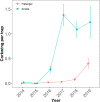Not that clean: Aquaculture-mediated translocation of cleaner fish has led to hybridization on the northern edge of the species' range
- PMID: 34178105
- PMCID: PMC8210792
- DOI: 10.1111/eva.13220
Not that clean: Aquaculture-mediated translocation of cleaner fish has led to hybridization on the northern edge of the species' range
Abstract
Translocation and introduction of non-native organisms can have major impacts on local populations and ecosystems. Nevertheless, translocations are common practices in agri- and aquaculture. Each year, millions of wild-caught wrasses are transported large distances to be used as cleaner fish for parasite control in marine salmon farms. Recently, it was documented that translocated cleaner fish are able to escape and reproduce with local wild populations. This is especially a challenge in Norway, which is the world's largest salmon producer. Here, a panel of 84 informative SNPs was developed to identify the presence of nonlocal corkwing wrasse (Symphodus melops) escapees and admixed individuals in wild populations in western Norway. Applying this panel to ~2000 individuals, escapees and hybrids were found to constitute up to 20% of the local population at the northern edge of the species' distribution. The introduction of southern genetic material at the northern edge of the species distribution range has altered the local genetic composition and could obstruct local adaptation and further range expansion. Surprisingly, in other parts of the species distribution where salmon farming is also common, few escapees and hybrids were found. Why hybridization seems to be common only in the far north is discussed in the context of demographic and transport history. However, the current lack of reporting of escapes makes it difficult to evaluate possible causes for why some aquaculture-dense areas have more escapees and hybrids than others. The results obtained in this study, and the observed high genomic divergence between the main export and import regions, puts the sustainability of mass translocation of nonlocal wild wrasse into question and suggests that the current management regime needs re-evaluation.
Keywords: Labridae; aquaculture; genetic hybridization; human‐mediated gene flow; parasites; single nucleotide polymorphism.
© 2021 The Authors. Evolutionary Applications published by John Wiley & Sons Ltd.
Conflict of interest statement
None declared.
Figures





Similar articles
-
Cleaner fish escape salmon farms and hybridize with local wrasse populations.R Soc Open Sci. 2018 Mar 21;5(3):171752. doi: 10.1098/rsos.171752. eCollection 2018 Mar. R Soc Open Sci. 2018. PMID: 29657779 Free PMC article.
-
Interbreeding between local and translocated populations of a cleaner fish in an experimental mesocosm predicts risk of disrupted local adaptation.Ecol Evol. 2019 May 9;9(11):6665-6677. doi: 10.1002/ece3.5246. eCollection 2019 Jun. Ecol Evol. 2019. PMID: 31236251 Free PMC article.
-
Demographic history has shaped the strongly differentiated corkwing wrasse populations in Northern Europe.Mol Ecol. 2020 Jan;29(1):160-171. doi: 10.1111/mec.15310. Epub 2019 Dec 4. Mol Ecol. 2020. PMID: 31733084
-
The Minderoo-Monaco Commission on Plastics and Human Health.Ann Glob Health. 2023 Mar 21;89(1):23. doi: 10.5334/aogh.4056. eCollection 2023. Ann Glob Health. 2023. PMID: 36969097 Free PMC article. Review.
-
A review of potential pathogens of sea lice and the application of cleaner fish in biological control.Pest Manag Sci. 2002 Jun;58(6):546-58. doi: 10.1002/ps.509. Pest Manag Sci. 2002. PMID: 12138621 Review.
Cited by
-
Global, regional, and cryptic population structure in a high gene-flow transatlantic fish.PLoS One. 2023 Mar 20;18(3):e0283351. doi: 10.1371/journal.pone.0283351. eCollection 2023. PLoS One. 2023. PMID: 36940210 Free PMC article.
-
Hybridization and Introgression in Black Hakes (Merluccius polli and M. senegalensis): Evolutionary Dynamics and Conservation Implications in the Contact Zone Exploited by Multi-Species Fisheries.Mol Ecol. 2025 Feb;34(4):e17654. doi: 10.1111/mec.17654. Epub 2025 Jan 10. Mol Ecol. 2025. PMID: 39791935 Free PMC article.
-
Combining population genomics with demographic analyses highlights habitat patchiness and larval dispersal as determinants of connectivity in coastal fish species.Mol Ecol. 2022 May;31(9):2562-2577. doi: 10.1111/mec.16415. Epub 2022 Mar 15. Mol Ecol. 2022. PMID: 35229385 Free PMC article.
-
Feeding global aquaculture.Sci Adv. 2024 Oct 18;10(42):eadn9698. doi: 10.1126/sciadv.adn9698. Epub 2024 Oct 16. Sci Adv. 2024. PMID: 39413172 Free PMC article. Review.
-
Urban rendezvous along the seashore: Ports as Darwinian field labs for studying marine evolution in the Anthropocene.Evol Appl. 2022 Jul 19;16(2):560-579. doi: 10.1111/eva.13443. eCollection 2023 Feb. Evol Appl. 2022. PMID: 36793678 Free PMC article.
References
-
- Allendorf, F. W. , Luikar, G. , & Aitken, S. N. (2013). Conservation and the genetics of populations (2nd ed.). Wiley‐Blackwell.
-
- Atalah, J. , & Sanchez‐Jerez, P. (2020). Global assessment of ecological risks associated with farmed fish escapes. Global Ecology and Conservation, 21, e00842. 10.1016/j.gecco.2019.e00842 - DOI
-
- Besnier, F. , Kent, M. , Skern‐Mauritzen, R. , Lien, S. , Malde, K. , Edvardsen, R. B. , Taylor, S. , Ljungfeldt, L. E. R. , Nilsen, F. , & Glover, K. A. (2014). Human‐induced evolution caught in action: SNP‐array reveals rapid amphi‐atlantic spread of pesticide resistance in the salmon ectoparasite Lepeophtheirus salmonis . BMC Genomics, 15(1), 937. 10.1186/1471-2164-15-937 - DOI - PMC - PubMed
LinkOut - more resources
Full Text Sources

